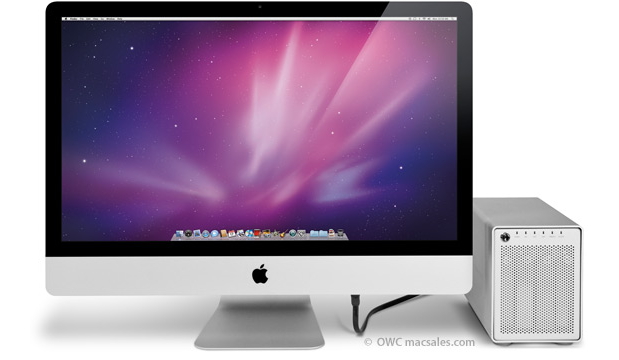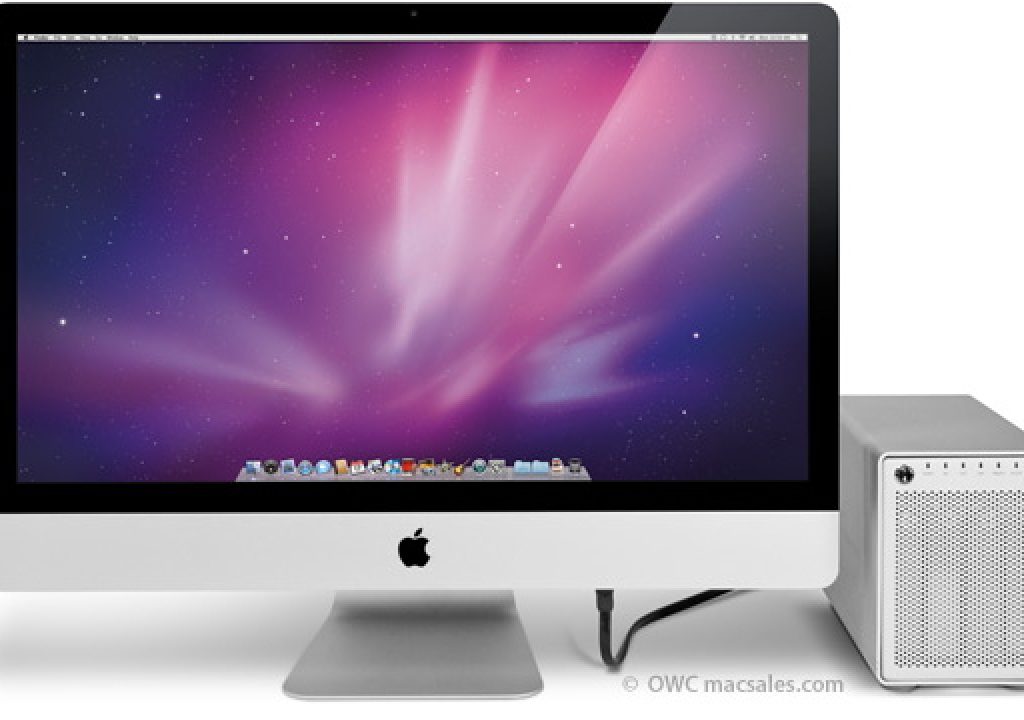
Although it has been in existence for many years and is known to be among the best and fastest ways to connect local external hard drives or disk arrays to a computer, Apple strangely has been the only computer manufacturer to my knowledge which has not yet offered a direct eSATA port on any of its computers. Even way back in the Apple G5 tower era, I used to add eSATA ports to high-end video editing systems I integrated, and this of course has continued with the MacPro (Intel) era of Apple towers. The lack of direct eSATA port on all other Macs [iMac, MacBook(Pro), and Mac Mini] has sadly meant that video editors have had to settle for slower FireWire 800 speeds… until now. The highly respected OWC (Other World Computing) is now offering a US$169 custom modification to iMac 27″ (mid 2010 models) to add eSATA, which untaps 3.3 times faster performance with an external disk array or SSD, compared to FireWire 800. This article will cover what the extra speed means to a video editor, how eSATA has been added to Macs before (with compromises), the advantages of OWC’s new official upgrade plan, and how to do critical video evaluation monitoring with an iMac.
What does extra disk speed means to a video editor?
Chart courtesy of OWC.
When you edit multilayer video, your disk array needs to play back multiple video streams simultaneously. Each video layer as a finite bandwidth requirement, and whatever it is, it is multiplied by the number of layers you expect to edit in real time. In addition, FireWire has always been known to have “hiccup” issues. When you go eSATA (external SATA), you are fortunately eliminating any conversion to FireWire, and addressing the drive directly via its external interface, which is SATA. So with eSATA as your connection to your fast disk array (as opposed to any current type of FireWire) you get better general performance, and you can edit more layers in real time without dropped frames, and/or without having to render first, and/or having to throttle down the quality.
How eSATA has been added to non-tower Macs before, with compromises
It has been possible to add eSATA to the few MacBookPro models that have an ExpressCard/34 slot by adding an eSATA card to it, although that unfortunately means that you then can’t connect something else to the ExpressCard/34 slot simultaneously, like a Matrox MXO2 Mini with MAX, or an AJA IoExpress. Also, the Internet is full of articles which show how to add eSATA to an older Mac Mini, although that meant no longer having any internal drive, so for serious video editing, it meant a FireWire system drive, and then a disk array connected via eSATA. So far, it seems much more difficult to do this with the latest 2010 version of the Mini.
Advantages of OWC’s iMac 27″ upgrade plan
Unlike prior modifications on the Mac Mini, OWC’s modification does not sacrifice an internal drive. OWC says that their modification should not affect the Apple warranty on the iMac. In fact, in addition to adding the eSATA option, OWC also offers other possibilities while your iMac is at their shop, including making your internal system drive an SSD.
Why add internal SSDs (Solid State Drives)?
Chart courtesy of OWC.
OWC says:
Other World Computing’s Turnkey Upgrade Program for the 2010 Apple iMac 27″ allows you to add or upgrade to OWC Mercury Extreme Pro SSDs up to 480GB. Adding an SSD to your iMac not only will decrease boot time and increase the speed in which you can access your data, but with multiple OWC Mercury Extreme Pro SSDs, you can achieve transfer rates so high, it will give you near instantaneous access to all your data.
We took our stock 27-inch 3.2GHz Intel Core i3 iMac and ran QuickBench on the internal 7200 rpm platter-based hard drive. At 123MB/sec we were already well over the 100MB/sec transfer rate of any FireWire 800 external hard drive. Replacing that drive with a single 240GB Mercury Extreme Pro SSD resulted in more than double the speed!
Here’s where it got interesting though…as OWC can install up to three Solid State Drives in a single 27-inch iMac, rather than keep them as separate locations, we used Disk Utility to concatenate the drives into a single RAID0 (Striped) volume*. The transfer rates then increased dramatically achieving rates up to 6 times faster than the stock hard drive alone!
In addition to the performance benefits of SSD, this will also likely improve the reliability of the iMac, since magnetic drives are much more likely to fail than SSDs. That’s something nice to know with a product like today’s iMac, where only a “jeweler” will dare to open it to change a hard drive.
RAID5 disk arrays to connect via eSATA to an iMac
Although OWC would certainly love to have you purchase one of their own OWC Mercury Elite-AL Pro units, other RAID5 units with an onboard RAID5 controller, including the Promise SmarStor 4600 (which I covered in January 2010 -and is available bundled with drives- from store.apple.com) and the Drobo S. Although Drobo doesn’t use RAID5, their BeyondRAID technology offers the same main advantages as RAID5 (extra speed and redundancy), plus other advantages too.
Have your customized iMac drop-shipped from Apple to OWC!
If you haven’t purchased an iMac yet and you live in the USA, OWC even encourages you to place your order directly at store.apple.com to your specs, and then have your built-to-order 27″ iMac drop-shipped directly to OWC for your eSATA and other upgrades. That way, your new iMac will travel less, and you’ll potentially pay less in freight if you receive free shipping from Apple. When you do that, strongly consider ordering it with a Spanish keyboard at no extra charge. Many ProVideo Coalition readers may recall my recommendation to order your Mac with a Spanish keyboard, even if you type mainly -or exclusively- in English, as I explained in February 2009. The Spanish ISO keyboard is the most universal keyboard in the world for languages which use the Latin/Roman alphabet, and are the only keyboards capable of direct access to the accented characters used to type in Catalán, Castilian, English, French, Italian, and Portuguese (at least). The Spanish ISO keyboard also has direct access to the € (euro symbol) in addition to the $ (dollar/peso symbol). It will be very interesting to know how many iMac orders end up drop-shipped to OWC, and I hope that either Apple or OWC reveals that information within a few months. If the number is very high, maybe Apple will reconsider adding eSATA ports to the iMac and other Macs directly from the factory in future models.
39-point FAQ about the eSATA upgrade
At publication time of this article, I counted 39 questions and answers in OWC’s FAQ about the eSATA upgrade. It may have grown by the time you read it!
My wish list for OWC
- Offer an eSATA upgrade for the new 2010 Mac Mini too
- Offer a display transplant to matte on the 2010 iMac, as TechRestore.com already does with the MacBookPro 13″, as covered very well by Rob Griffiths of Macworld.
- Add an ExpressCard/34 slot upgrade to both the 2010 iMac and the 2010 Mac Mini
I realize that the third wish is almost impossible, unless there’s already a hidden port on the motherboard.
How to do critical video monitoring from an iMac
If you are planning to edit with iMovie ’09 or Final Cut Pro, your solution for critical video evaluation monitoring is Matrox’s original MXO, plus an obligatory adaptor that goes from Mini DisplayPort to DVI for under US$14, as I covered in detail in Matrox’s original MXO crashes the direct DreamColor interface party in January 2010. In that case, I also highly recommend a cable to go from DVI to HDMI, since that way the DreamColor monitor will offer you the 1:1 pixel monitoring option, which is not available via the DreamColor’s DVI input. (I have also observed this to be the case with other brands of monitors, which may call the 1:1 in other terminology including “Just Fit”, although with many other brands, the 1:1 mode often works only when receiving 1920×1080, but not with 1280×720, which the DreamColor monitor fortunately does offer for both types of sources.)
On the other hand, if you are going to edit with Premiere CS5 and you have determined that you meet the four requirements I published in Does Premiere CS5 achieve the “impossible dream” for critical evaluation monitoring?, then you can really just connect a DreamColor monitor directly to the iMac. In that case, you’ll just need a special cable to go from Mini DisplayPort to Displayport for under US$8. since the DreamColor has a DisplayPort input too.
Listen to our upcoming interview with OWC on TecnoTur
We are already in round three of our conversations with OWC’s public relations department, and expect to be recording an interview with them very soon about these topics, so you’ll likely hear our interview with them in an upcoming episode of TecnoTur. Consider subscribing now for free so you won’t miss it.
Allan T©pper’s consulting, articles, seminars, and audio programs
Contact Allan T©pper for consulting, or find a full listing of his articles and upcoming seminars and webinars at AllanTepper.com. Listen to his TecnoTur program, which is now available both in Castilian and in English, free of charge. Search for TecnoTur in iTunes or visit TecnoTur.us for more information.
Disclosure, to comply with the FTC’s rules
Neither OWC or any manufacturer is paying Allan T©pper or TecnoTur LLC specifically to write this article. Some of the manufacturers listed above have contracted T©pper and/or TecnoTur LLC to carry out consulting and/or translations/localizations/transcreations, and some of them have sent him equipment for evaluations or reviews. So far, none of the manufacturers listed above is/are sponsors of the TecnoTur programs, although they are welcome to do so, and some are, may be (or may have been) sponsors of ProVideo Coalition magazine. Some links to third parties listed in this article and/or on this web page may indirectly benefit TecnoTur LLC indirectly via affiliate programs.
Post from Anthony Burokas, who had technical issues with this web page
Can’t post to Pro Video Coalition (keeps giving me an error message, probably because of the links) so I’ll post to you and you can post it to the article if you like.
Excellent reporting.
I hope Apple sees the trend and makes a little more movement to providing additional capability to pro users who don’t want to blow $5000 on the core computer. It was years ago that I, too, pined away for a Mac Mini Pro, (http://ieba.wordpress.com/2008/02/15/openlet) and agree whole heartedly with you that a Mini with an ExpressCard slot would suit many prosumer professionals to a T.
Given that the Mini is laptop guts, and laptops have ExpressCard slots, it wouldn’t be that hard, but then again, Apple is the only company who thinks putting the slot for your digital camera media on the BACK of the computer is a good idea.
I recently reviewed the Sonnet Qio (http://www.eventdv.net/Articles/News/Feature/In-the-Field-Sonnet-Qio-68132.htm) and found it to be the best accessory you can have for your ExpressCard equipped laptop- and it gives you TWO ExpressCard slots, so you can use that MXO2, and the eSATA RAID too.
Eventually when companies start incorporating the ExpressCard 2.0 standard (http://en.wikipedia.org/wiki/Expresscard#ExpressCard_2.0) into computers (and the next Qio) then we can enjoy double the bandwidth of the current ExpressCard.
Now, if nVidia can give me an ExpressCard stick (or two) I can use to accelerate CS5 in my Qio equipped MacBook, then I’ll really be styling.
Anthony Burokas
IEBA.com

